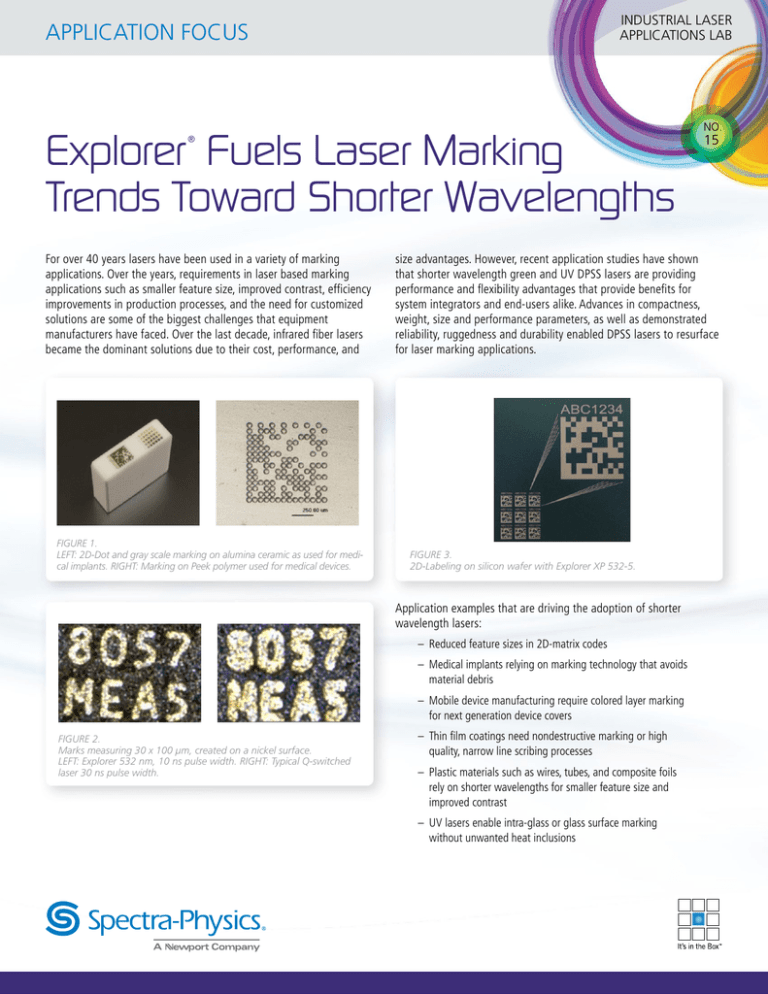
INDUSTRIAL LASER
APPLICATIONS LAB
APPLICATION FOCUS
Explorer Fuels Laser Marking
Trends Toward Shorter Wavelengths
®
For over 40 years lasers have been used in a variety of marking
applications. Over the years, requirements in laser based marking
applications such as smaller feature size, improved contrast, efficiency
improvements in production processes, and the need for customized
solutions are some of the biggest challenges that equipment
manufacturers have faced. Over the last decade, infrared fiber lasers
became the dominant solutions due to their cost, performance, and
FIGURE 1.
LEFT: 2D-Dot and gray scale marking on alumina ceramic as used for medical implants. RIGHT: Marking on Peek polymer used for medical devices.
15
size advantages. However, recent application studies have shown
that shorter wavelength green and UV DPSS lasers are providing
performance and flexibility advantages that provide benefits for
system integrators and end-users alike. Advances in compactness,
weight, size and performance parameters, as well as demonstrated
reliability, ruggedness and durability enabled DPSS lasers to resurface
for laser marking applications.
FIGURE 3.
2D-Labeling on silicon wafer with Explorer XP 532-5.
Application examples that are driving the adoption of shorter
wavelength lasers:
– Reduced feature sizes in 2D-matrix codes
– Medical implants relying on marking technology that avoids
material debris
– Mobile device manufacturing require colored layer marking
for next generation device covers
FIGURE 2.
Marks measuring 30 x 100 µm, created on a nickel surface.
LEFT: Explorer 532 nm, 10 ns pulse width. RIGHT: Typical Q-switched
laser 30 ns pulse width.
NO.
– Thin film coatings need nondestructive marking or high
quality, narrow line scribing processes
– Plastic materials such as wires, tubes, and composite foils
rely on shorter wavelengths for smaller feature size and
improved contrast
– UV lasers enable intra-glass or glass surface marking
without unwanted heat inclusions
Explorer® Fuels Laser Marking
Trends Toward Shorter Wavelengths
The Explorer® laser family is built on proven, dependable, and reliable
DPSS architectures, and includes wavelength options at 349, 355, 532,
and 1064 nm. Outstanding mode quality with typical M2 values of 1.1 or
less and short pulse widths as low as 4 ns bundled with high peak power
enable highest quality parts marking. Explorer lasers are equipped with
feature rich software capabilities intended to shorten product integration
cycles when developing new marking tools or even table top instruments.
E-Pulse™ is a very useful feature that provides constant pulse energy over a
range of repetition rates and is a great solution when integrating the laser
into both gantry and scanner based systems alike.
The Explorer product family includes the It’s in the Box™ Explorer XP 532-5,
Explorer XP 355-1, Explorer One™ 355 and 349 nm compact, all-in-one
lasers. Competitive products are at least seven times bigger than these
Explorer XP 532-5 Typical Performance
6
24
5
20
4
16
3
12
2
1
50
100
150
200
0
0.5
1.6
24
1.4
21
1.2
18
1
15
0.8
12
0.6
9
Average Power
Pulse Width
Pulse Energy Noise
0.4
0.00
0.2
250
300
Units
3
0
40
FIGURE 4.
System-to-system reliability of the Explorer 355-300
6
60
80
100
120
140
160
180
Pulse Width (ns)
Pulse Energy Noise (%)
M2
Average Power (W)
1.0
200
300
Explorer XP 355-1 Typical Performance
(x)
(y)
150
250
Pulse Repetition Frequency (kHz)
FIGURE 5.
Typical performance of the Explorer XP 532-5
1.5
100
4
0
System-to-System Reliability
50
8
Average Power
Pulse Width
Pulse Energy Noise
Pulse Width (ns)
Pulse Energy Noise (%)
Miniaturization, smaller, more compact instruments and tools drive the
need for Explorer lasers.
pocket-sized Explorer lasers. Explorer lasers have outstanding performance
and size advantages where the ultra-compact laser head includes everything for a fast, simple, and cost efficient integration into your marking
system or tool.
Average Power (W)
EXPLORER FAMILY POWERS SHORT WAVELENGTH
MARKING APPLICATIONS
200
0
Pulse Repetition Frequency (kHz)
FIGURE 6.
Typical performance of the Explorer XP 355-1
EXPLORER MODELS FOR MARKING APPLICATIONS
Model
Explorer One 349-120
Wavelength
Power/Energy
Repetition Rate
349 nm
>120 µJ
Single shot – 20 kHz
Explorer One 355-300
355 nm
300 mW
Single shot to 200 kHz
Explorer XP 355-1
355 nm
1W
Single shot to 200 kHz
Explorer XP 532-5
532 nm
5W
Single shot to 300 kHz
3635 Peterson Way, Santa Clara, CA 95054, USA
PHONE: 1-800-775-5273 1-408-980-4300 FAX: 1-408-980-6921 EMAIL: sales@spectra-physics.com
www.spectra-physics.com
China +86-10-6267-0065 France +33-(0)1-60-91-68-68
Japan +81-3-3794-5511 Taiwan +886 -(0)2-2508-4977
Singapore +65-6664-0400 china@newport.com
france@newport.com
spectra-physics@splasers.co.jp
sales@newport.com.tw
sales.sg@newport.com
Belgium
+32-(0)0800-11 257 belgium@newport.com
Netherlands
+31-(0)30 6592111 netherlands@newport.com
United Kingdom +44-1235-432-710uk@newport.com
Germany / Austria / Switzerland
+49-(0)6151-708-0 germany@newport.com
© 2014 Newport Corporation. All Rights Reserved. Explorer, Spectra-Physics and the Spectra-Physics logo are registered trademarks of Newport Corporation. E-Pulse and It’s in the Box are trademarks of Newport Corporation. Spectra-Physics Santa
Clara, California, Stahnsdorf, Germany and Rankweil, Austria have all been certified compliant with ISO 9001.
SP-DS-20140922-12
